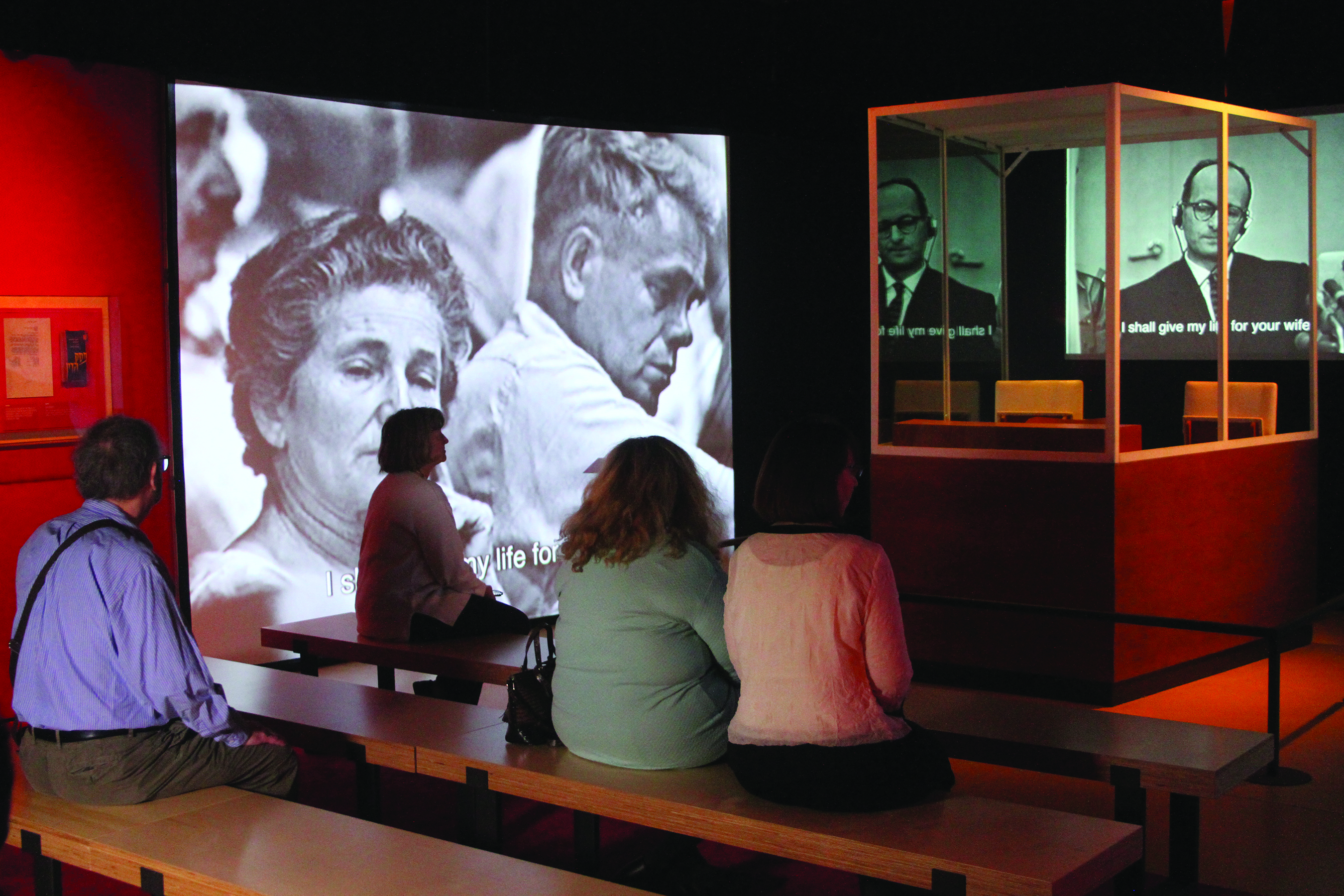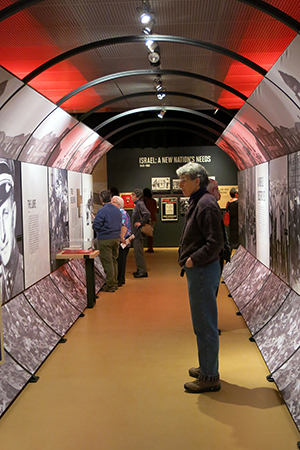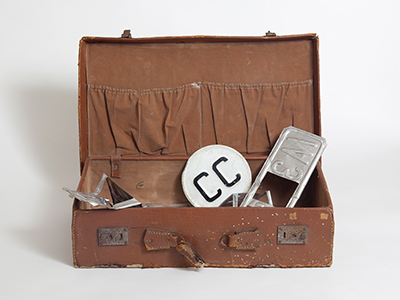Arts
Exhibit
The Mossad’s Covert Capture of Eichmann, on Display

“Covert.” This is not a word typically used to describe a museum exhibit. But, then, most exhibits are not created in association with the Mossad, Israel’s intelligence service.
And most historical artifacts in museums do not require declassification. The objects on display in “Operation Finale: The Capture & Trial of Adolf Eichmann” are connected to the clandestine capture and subsequent trial of Mercedes-Benz employee Ricardo Klement.
Klement was the false identity assumed by one of the world’s most notorious escaped war criminals: SS officer Adolf Eichmann. He managed the transport of millions of innocents to death camps and was a key perpetrator of what Hitler called “the final solution to the Jewish question.”
The exhibit, produced by the Maltz Museum of Jewish Heritage in Beachwood, Ohio, in collaboration with the Mossad and Beit Hatfutsot–The Museum of the Jewish People in Tel Aviv, includes photographs and objects from the daring capture as well as short films and an incredible immersive installation on the trial.
“Operation Finale,” which will be at the Maltz through July 24 before traveling to other venues throughout the United States, references the code name given to the Mossad’s apprehension of Eichmann in Argentina in 1960, where he had been hiding since 1950 after escaping Germany and then Italy with a falsified Red Cross passport. After his high-risk capture, kidnapping and subsequent nine months of interrogation in Israel, Eichmann stood trial and was found guilty of 15 charges of crimes against humanity and war crimes.
“This is the first time the Mossad has allowed archival materials related to one of its clandestine operations to leave Israel,” says Ellen Rudolph, executive director of the Maltz. “We have been working with our international partners for more than two years to assemble this new exhibition.”

To enter the exhibit, you must first be transported back in time by walking through a tunnel lined with period photographs. The black-and-white images encapsulate the systematic persecution of the Nazi era that led to the Holocaust, from the identification and separation of Jews and confiscation of their citizenship and property to their deportation, imprisonment, exploitation and extermination.
At the end of the tunnel is the 4,000-square-foot exhibition that details the circumstances that alerted Israeli agents to Eichmann’s location in South America, the espionage associated with surveillance and identity confirmation and the elaborate plan to capture and smuggle Eichmann out of Argentina.
“The entire dramatic story is told, including never-before-revealed details,” explains former agent and espionage expert Avner Avraham, who curated the materials for the Mossad in Israel.
Well, not the entire story.
The first part of the exhibit takes on the same covert nature of the mission itself, some of which is intentional and some of which is due to the still-classified materials not yet available for public consumption. The winding path through the self-guided exhibition space is purposefully nebulous, leaving too many options to follow and too few clues to help lead viewers in the right direction. If you veer off course, you find artifacts without context, information without proper introduction and dead ends.
Welcome to the world of Rafi Eitan, Yaakov Gat, Peter Zvi Malkin, Zvi Aharoni and the handful of other Mossad agents sent to Argentina to find and capture Eichmann.
Parts of the exhibit provide extraordinarily minute details of undercover activities, such as the manufacturing of false license plates during the mission and the forging of crew credentials for El Al Israel Airlines, which facilitated the exit strategy once Eichmann was in captivity. The pens, ink and stamps used to falsify the documents are all on display.
But there are events and activities that seem to have been less well documented, resulting in displayed materials that are inconsequential. Clearly, the significance of art and artifact is in the eye of the beholder, but the airline tickets used by the Mossad agents to travel to Argentina, the car rental forms for the vehicles they used in the operation and a map of a never-used escape route for an alternate plan of abduction that was never implemented are underwhelming.

Collectively, however, the 60 original artifacts, 70 photographs and a short film that reenacts the dramatic abduction offer intriguing glimpses of what transpired during Operation Finale.
Many of the abduction-associated artifacts on display are fascinating. Particularly so is Aharoni’s spy camera that captured candid images of Eichmann staring into the distance in Buenos Aires as well as Aharoni’s pocket diary containing written notes recorded during the week of the operation.
And the artifacts and films associated with Eichmann’s interrogation and trial, which take up the second half of the gallery space, are extremely impressive.
Short films allow us to hear directly from the abduction team and the legal team that prosecuted Eichmann, including chief prosecutor Gideon Hausner. We also hear from Michael Goldman-Gilad, an Israeli police inspector and one of the investigation officers who conducted the interrogation.
Goldman-Gilad was not only one of Eichmann’s prosecutors; he was also a victim of the Nazis. As a child in a labor camp in the Przemysl ghetto in southeastern Poland, he once endured 80 lashes at the hands of an SS officer. He was eventually transferred to Auschwitz–Birkenau, where the camp population in August 1944 was 105,168. The last roll call five months later showed 64,000 inmates, including Goldman-Gilad.
After the establishment of the state of Israel, he immigrated to Tel Aviv and enlisted in the police force. His rapid rise in the ranks as well as his experiences in the camps made Goldman-Gilad a good choice to investigate Eichmann’s role in the murder of the Jews of Europe. And after Eichmann was convicted and executed, it was Goldman-Gilad who scattered Eichmann’s ashes over the waters of the Mediterranean in 1962, just outside of Israeli territorial waters.
The exhibit’s pièce de résistance is in an alcove just around the corner from the video screen displaying Goldman-Gilad’s story. It is an immersive installation that contains the actual bulletproof glass booth that housed Eichmann during the historic 1961 trial.
Projected inside the booth are the filmed images of a dispassionate Eichmann listening to one witness after another, with the testimonies projected on the right wall of the installation while images of observers in the courtroom are projected on the left wall. All this creates the powerful impression of being dropped into the middle of the courtroom.

Several rows of wooden benches beckon you to sit, watch and witness. It is impossible to leave until the loop of film footage comes to a close as Eichmann, carrying a pile of ledgers, books and notes, is escorted out of the booth and back to his prison cell.
“Although it was more than 15 years after the end of World War II,” notes Orit Shaham-Gover, chief curator at Beit Hatfutsot, “this was the first time many survivors publicly shared their stories. These moving accounts of pain, suffering, courage and survival were broadcast across the globe, providing a deeper, more complete understanding of the Holocaust that became not only a living part of Jewish identity, but of the world’s conscience.”
Seeing Eichmann under guard and on trial, after just learning about his elaborate abduction, is thoroughly engaging. It is at this stage of the exhibit where viewers are most likely to feel like an impassioned participant rather than a vested observer. As the Maltz’s Rudolph observes, it “kind of raises you up and punches you in the stomach.”
On the back wall of the alcove, which leads to the exhibit’s exit, is another remarkable artifact: Eichmann’s original handwritten request to Israeli President Yitzhak Ben-Zvi for a pardon and commutation of his death sentence.
Eichmann penned the three-page letter in German two days before he was executed. In it, according to an accompanying translation, Eichmann repeats the same infamous words heard so often during the 13 trials held in Nuremberg, Germany, between 1945 and 1949. There, the defendants—including Nazi Party officials and high-ranking officers—claimed that they were just following orders.
As if to reinforce the absurdity of this statement and give a face to the victims of Eichmann’s enterprise, suspended photographs of Holocaust survivors hang from the ceiling of the exhibit.
“Operation Finale” not only illustrates the enormity of the crimes committed during the Nazi regime, it also underscores the exceptional ingenuity behind this covert operation performed by a fledgling state with a newly designed national intelligence agency during a predigital era.
And, of course, says Rudolph, the exhibit drives home the need to “remain ever vigilant against indifference and intolerance in the world.”
On Tour
Maltz Museum of Jewish Heritage, Beachwood, Ohio, through July 24
Illinois Holocaust Museum & Education Center, Chicago, Ill., through June, 18 2017
Florida Holocaust Museum February 10, 2017 to June, 10, 2018
The exhibit will be traveling to additional venues. Check the Maltz’s website for updated information.
Bob Abelman is a theater critic and entertainment writer for the Cleveland Jewish News.










 Facebook
Facebook Instagram
Instagram Twitter
Twitter
Zad Leavy says
I covered the Eichmann Trial for the Hearst Wire Service and the Los Angeles Examiner, and attended the entire trial from beginning to end. As a lawyer, my articles also appeared in the American Bar Journal, the California Bar Journal, and in other legal journals throughout the U.S. Living in Jerusalem for those five months was the experience of a lifetime!
Zad Leavy says
The Hadassah